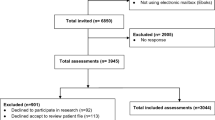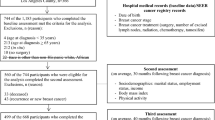Abstract
The RACS sentinel node biopsy versus axillary clearance (SNAC) trial compared sentinel-node-based management (SNBM) and axillary lymph-node dissection (ALND) for breast cancer. In this sub study, we sought to determine whether patient ratings of arm swelling, symptoms, function and disability or clinicians’ measurements were most efficient at detecting differences between randomized groups, and therefore, which of these outcome measures would minimise the required sample sizes in future clinical trials. 324 women randomised to SNBM and 319 randomised to ALND were included. The primary endpoint of the trial was percentage increase in arm volume calculated from clinicians’ measurements of arm circumference at 10 cm intervals. Secondary endpoints included reductions in range of motion and sensation (both measured by clinicians); and, patients’ ratings of arm swelling, symptoms and quality of life, using the European Organisation for Research and Treatment of Cancer Breast Cancer Module (EORTC QLM-BR23), the body image after breast cancer questionnaire (BIBC) and the SNAC study specific scales (SSSS). The relative efficiency (RE, the squared ratio of the test statistics, with 95% confidence intervals calculated by bootstrapping) was used to compare these measures in detecting differences between the treatment groups. Patients’ self-ratings of arm swelling were generally more efficient than clinicians’ measurements of arm volume in detecting differences between treatment groups. The SSSS arm symptoms scale was the most efficient (RE = 7.1) The entire SSSS was slightly less so (RE = 4.6). Patients’ ratings on single items were 3–5 times more efficient than clinicians’ measurements. Primary endpoints based on patient-rated outcome measures could reduce the required sample size in future surgical trials.
Similar content being viewed by others
References
Boyle P (2005) Breast cancer control: signs of progress but more work needed. Breast 14(6):429–438. doi:10.1016/j.breast.2005.10.001
National Breast and Ovarian Cancer institute—Key Facts about breast cancer in Australia (2006) http://www.breasthealth.com.au/statisticsresearch. Accessed 25 Mar 2008
Aitken RJ et al (1989) Arm morbidity within a trial of mastectomy and either nodal sample with selective radiotherapy or axillary clearance. Br J Surg 76(6):568–571. doi:10.1002/bjs.1800760613
Arnaud S et al (2004) Patients’ and surgeons’ perspectives on axillary surgery for breast cancer. Eur J Surg Oncol 30(7):735–743. doi:10.1016/j.ejso.2004.05.007
Barranger E et al (2005) Subjective morbidity and quality of life after sentinel node biopsy and axillary lymph node dissection for breast cancer. J Surg Oncol 92(1):17–22. doi:10.1002/jso.20343
Coster S, Poole K, Fallowfield LJ (2001) The validation of a quality of life scale to assess the impact of arm morbidity in breast cancer patients post-operatively. Breast Cancer Res Treat 68(3):273–282. doi:10.1023/A:1012278023233
Culter SJ, Black MM, Goldenberg IS (1963) Prognostic factors in cancer of the female breast. An investigation of some interrelations. Cancer 16:1589–1597
Kuehn T, Klauss W, Darsow M, Regele S, Flock F, Maiterth C, Dahlbender R, Wendt I, Kreienberg R (2006) Long-term morbidity following axillary dissection in breast cancer patients-clinical assessment, significance for life quality and the impact of demographic, oncologic and therapeutic factors. Breast Cancer Res Treat 64(3):275–286. doi:10.1023/A:1026564723698
Keramopoulos A, Tsionou C, Minaretzis D, Michalas S, Aravantinos D (1993) Arm morbidity following treatment of breast cancer with total axillary dissection: a multivariated approach. Oncology 50(6):445–449
Kissin MW et al (1986) Risk of lymphoedema following the treatment of breast cancer. Br J Surg 73(7):580–584. doi:10.1002/bjs.1800730723
Roses DF, Brooks AD, Harris MN, Shapiro RL, Mitnick J (1999) Complications of level I and II axillary dissection in the treatment of carcinoma of the breast. Ann Surg 230:194–201. doi:10.1097/00000658-199908000-00009
Erickson VS et al (2001) Arm edema in breast cancer patients. J Natl Cancer Inst 93(2):96–111. doi:10.1093/jnci/93.2.96
Larson D et al (1986) Edema of the arm as a function of the extent of axillary surgery in patients with stage I–II carcinoma of the breast treated with primary radiotherapy. Int J Radiat Oncol Biol Phys 12(9):1575–1582
Liljegren G, Holmberg L (1997) Arm morbidity after sector resection and axillary dissection with or without postoperative radiotherapy in breast cancer stage I. Results from a randomised trial. Uppsala-orebro breast cancer study group. Eur J Cancer 33(2):193–199. doi:10.1016/S0959-8049(96)00375-9
Oxford English Dictionary (1989) Lymphoedema definition. Oxford University press, Oxford
Logan V (1995) Incidence and prevalence of lymphoedema, a literature review. J Clin Nurs 4:213–219
Gerber LH (1998) A review of measures of lymphedema. Cancer 83(12 Suppl American):2803–2804
Haid A et al (2002) Morbidity of breast cancer patients following complete axillary dissection or sentinel node biopsy only: a comparative evaluation. Breast Cancer Res Treat 73(1):31–36. doi:10.1023/A:1015234318582
Fleissig A, Fallowfield LJ, Langridge CI, Johnson L, Newcombe RG, Dixon JM et al (2006) Post-operative arm morbidity and quality of life. Results of the ALMANAC randomised trial comparing sentinel node biopsy with standard axillary treatment in the management of patients with early breast cancer. Breast Cancer Res Treat 95:279–293. doi:10.1007/s10549-005-9025-7
Schrenk P et al (2000) Morbidity following sentinel lymph node biopsy versus axillary lymph node dissection for patients with breast carcinoma. Cancer 88(3):608–614. doi:10.1002/(SICI)1097-0142(20000201)88:3<608::AID-CNCR17>3.0.CO;2-K
Mansel RE, Fallowfield L, Kissin M, Goyal A, Newcombe RG, Dixon JM et al (2006) Randomized multicentre trial of sentinel node biopsy versus standard axillary treatment in operable breast cancer: the ALMANAC trial. J Natl Cancer Inst 98(9):599–609
Veronesi U et al (2005) Sentinel node biopsy in breast cancer: early results in 953 patients with negative sentinel node biopsy and no axillary dissection. Eur J Cancer 41(2):231–237. doi:10.1016/j.ejca.2004.05.009
Krag DN, Anderson SJ, Julian TB, Brown AM, Harlow SP (2007) Technical outcomes of sentinel-lymph node resection and conventional axillary lymph-node dissection in patients with clinically node-negative breast cancer: results from the NSABP-32 randomised phase III trial. Lancet Oncol 8(10):881–888. doi:10.1016/S1470-2045(07)70278-4
Krag DN et al (2004) NSABP-32: phase III, randomized trial comparing axillary resection with sentinal lymph node dissection: a description of the trial. Ann Surg Oncol 11(3 suppl):208S–210S
Ung OA (2004) Australasian experience and trials in sentinel lymph node biopsy: the RACS SNAC trial. Asian J Surg 27(4):284–290
Veronesi U et al (2003) A randomized comparison of sentinel-node biopsy with routine axillary dissection in breast cancer. N Engl J Med 349(6):546–553. doi:10.1056/NEJMoa012782
Purushotham AD, Upponi S, Klevesath MB, Bobrow L, Millar K, Myles JP et al (2005) Morbidity after sentinel lymph node biopsy in primary breast cancer: results from a randomized controlled trial. J Clin Oncol 23(19):4312–4321. doi:10.1200/JCO.2005.03.228
Sprangers MA et al (1996) The European Organization for Research and Treatment of Cancer breast cancer-specific quality-of-life questionnaire module: first results from a three-country field study. J Clin Oncol 14(10):2756–2768
Baxter NN, Goodwin PJ, Mcleod RS, Dion R, Devins G, Bombardier C (2006) Reliability and validity of the body image after breast cancer questionnaire. Breast J 12(3):221–232. doi:10.1111/j.1075-122X.2006.00246.x
Martin AJ, Greatorex V, Simes RJ (1997) Towards a utility-based assessment for cancer patients: reliability and validity of the UBQ-C(cancer) items. Control Clin Trials 18:160s. doi:10.1016/S0197-2456(97)91176-4
Nowak AK, Hargreaves C, Gill PG, Wetzig N, Ung O, Campbell I, Kollias J, Young L, Macphee A, Gebski V, Stockler MR (2004) Health-related quality of life (HRQL) before and 1 month after axillary surgery in a randomized trial of sentinel node (SN) biopsy versus axillary clearance (AC): the SNAC trial. Breast Cancer Res Treat 88(1 supp):1
Murawski MM, Miederhoff PA (1998) On the generalizibility of statistical expressions of health related quality of life instrument responsiveness: a data synthesis. Qual Life Res 7:11–22. doi:10.1023/A:1008828720272
Norman G (1989) Issues in the use of change scores in randomized trials. J Clin Epidemiol 42(11):1097–1105. doi:10.1016/0895-4356(89)90051-6
Stockler MR et al (1998) Responsiveness to change in health-related quality of life in a randomized clinical trial: a comparison of the prostate cancer specific quality of life instrument (PROSQOLI) with analogous scales from the EORTC QLQ-C30 and a trial specific module. European Organization for Research and Treatment of Cancer. J Clin Epidemiol 51(2):137–145. doi:10.1016/S0895-4356(97)00269-2
Efron B, Tibshirani RJ (1993) An introduction to the bootstrap. Chapman Hall, New York, p 436
Gill G et al (2008) Sentinel-lymph-node-based management or routine axillary clearance? One-year outcomes of Sentinel Node Biopsy versus Axillary Clearance (SNAC), a randomised controlled surgical trial. Ann Surg Oncol (in press)
Kane RL (ed) (2006) Understanding health care outcomes research, 2nd edn. Jones & Bartlett, Boston
Streiner DL, Norman GR (2003) Health measurement scales: a practical guide to their development and use (Oxford medical publications), 3rd edn. Oxford University Press, Oxford, p 283
Belson WA (1981) The design and understanding of survey questions. Gower, Aldershot
Ronka R et al (2005) One-year morbidity after sentinel node biopsy and breast surgery. Breast 14(1):28–36. doi:10.1016/j.breast.2004.09.010
Sneeuw KC, Aaronson NK, Yarnold JR, Broderick M, Regan J, Ross G (1992) Cosmetic and functional outcomes of breast conserving treatment for early stage breast cancer. Comparison of patients’ ratings, observers’ ratings and objective assessments. Radiother Oncol 25:153–159. doi:10.1016/0167-8140(92)90261-R
Author information
Authors and Affiliations
Consortia
Corresponding author
Appendix
Appendix
Comparison of the relative efficiency of arm volume measurements with the SNAC study specific scales for those patients with complete data and those with incomplete data available.
Outcome measure | All patients | Patients with complete data | ||||||
|---|---|---|---|---|---|---|---|---|
MWW, P-value for difference between groups | MWW, z-score for difference between groups | Relative efficiencya (95% CI) | Required sample size | MWW, P-value for difference between groups | MWW, z-score for difference between groups | Relative efficiencya (95% CI) | Required sample size | |
Rated by clinicians | ||||||||
% Increase in arm vol | 0.001 | 3.3 | 1 | 1,000 | 0.008 | 2.7 | 1 | 1,000 |
Rated by patients | ||||||||
Arm disability subscale (3 items) | 0.1 | 3.0 | 0.8 (0.2–4) | 1,220 | 0.01 | 2.6 | 0.9 (0.1–7) | 1,090 |
Arm dysfunction subscale (4 items) | 0.006 | 3.5 | 1.1 (0.3–5) | 880 | 0.001 | 3.3 | 1.5 (0.3–10) | 680 |
SNAC study specific scales (15 items) | <0.0001 | 6.3 | 3.7 (1.4–15) | 270 | <0.0001 | 5.8 | 4.6 (2.0–28) | 220 |
Single arm swelling item “Arm swelling—how much has this aspect troubled you over the last 4 weeks” | <0.0001 | 6.6 | 4.0 (1.7–16) | 250 | <0.0001 | 6.0 | 5 (1.7–30) | 200 |
Arm symptoms subscale (7 items) | <0.0001 | 7.7 | 5.4 (2.3–22) | 180 | <0.0001 | 7.2 | 7.1 (2.6–46) | 140 |
Rights and permissions
About this article
Cite this article
Smith, M.J., Gill, P.G., Wetzig, N. et al. Comparing patients’ and clinicians’ assessment of outcomes in a randomised trial of sentinel node biopsy for breast cancer (the RACS SNAC trial). Breast Cancer Res Treat 117, 99–109 (2009). https://doi.org/10.1007/s10549-008-0202-3
Received:
Accepted:
Published:
Issue Date:
DOI: https://doi.org/10.1007/s10549-008-0202-3




